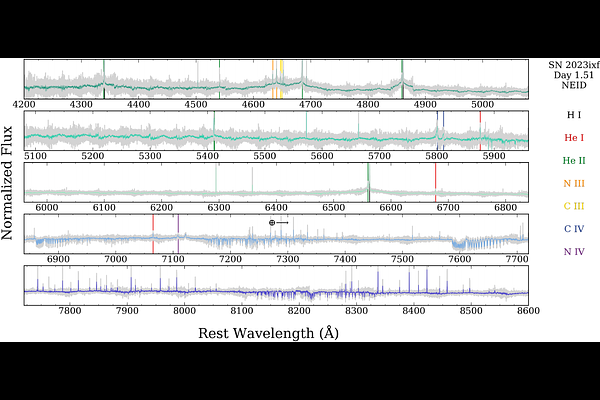The Immediate, eXemplary, and Fleeting echelle spectroscopy of SN 2023ixf: Monitoring acceleration of slow progenitor circumstellar material, driven by shock interaction

The Immediate, eXemplary, and Fleeting echelle spectroscopy of SN 2023ixf: Monitoring acceleration of slow progenitor circumstellar material, driven by shock interaction
Danielle Dickinson Purdue University, West Lafayette, IN, USA, Dan Milisavljevic Purdue University, West Lafayette, IN, USA Integrative Data Science Institute, West Lafayette, IN, USA, Braden Garretson Purdue University, West Lafayette, IN, USA, Luc Dessart Institut d'Astrophysique de Paris, CNRS-Sorbonne Universite, Paris, France, Raffaella Margutti Department of Astronomy, University of California, Berkeley, CA, USA, Ryan Chornock Department of Astronomy, University of California, Berkeley, CA, USA, Bhagya Subrayan Steward Observatory, University of Arizona, Tucson, AZ, USA, D. John Hillier Department of Physics and Astronomy & Pittsburgh Particle Physics, Astrophysics, and Cosmology Center, Eli Golub NSF NOIRLab, Tucson, AZ, USA, Dan Li NSF NOIRLab, Tucson, AZ, USA, Sarah E. Logsdon NSF NOIRLab, Tucson, AZ, USA, Jayadev Rajagopal NSF NOIRLab, Tucson, AZ, USA, Susan Ridgway NSF NOIRLab, Tucson, AZ, USA, Nathan Smith Steward Observatory, University of Arizona, Tucson, AZ, USA, Chuck Cynamon Supra Solem Observatory, Bradley, CA, USA
AbstractWe present high resolution WIYN/NEID echelle spectroscopy (R $\approx70$,000) of the supernova (SN) 2023ixf in M101, obtained 1.51 to 18.51 days after explosion over nine epochs. Daily monitoring for the first four days after explosion shows narrow emission features ($\leq200$ km s$^{-1}$), exhibiting predominantly blueshifted velocities, that rapidly weaken, broaden, and vanish in a manner consistent with radiative acceleration and the SN shock eventually overrunning or enveloping the full extent of dense circumstellar medium (CSM). The most rapid evolution is in the He I emission, which is visible on day 1.51 but disappears by day 2.62. We measure the maximum pre-SN speed of He I to be 25 $^{+0}_{-5} \pm2$ km s$^{-1}$, where the error is attributable to the uncertainty in how much the He I had already been radiatively accelerated, and to measurement of the emission line profile. The radiative acceleration of material is likely driven by the shock-CSM interaction, and the CSM is accelerated to $\geq200$ km s$^{-1}$ before being completely swept up by the SN shock to $\sim 2000$ km s$^{-1}$. We compare the observed spectra with spherically-symmetric r16wb HERACLES/CMFGEN model spectra and find the line evolution to generally be consistent with radiative acceleration and optical depth effects. The progenitor of SN2023ixf underwent an enhanced mass loss phase $\gtrsim 4$ year prior to core-collapse, creating a dense, asymmetric CSM region extending out to approximately $r_{CSM} = 3.7 \times 10^{14}$ ($v_\textrm{shock}$/9500 km s$^{-1}$) cm.